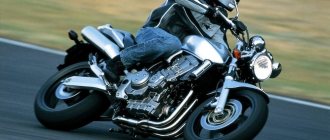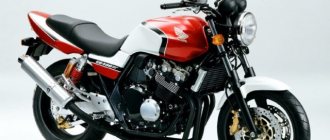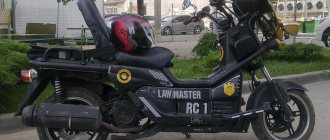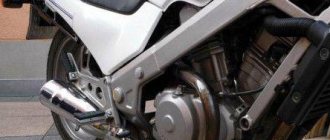Year of manufacture: 1996—1999
Liquids used and filling volumes Fork oil (in each feather): 561 ml Motul Fork Oil Expert Medium 10W Engine oil without filter: 3.4 l. Motul 7100 10W-40, Motul 300V 10W-40 Engine oil incl. filter: 3.6 l. Chain lube: Motul C4 Chain Lube Factory Line, Motul C5 Chain Paste Brake fluid: DOT 4 Antifreeze volume: 2.7 l. Motul Motocool Expert -37 Fuel tank capacity: 18.0 l.
Technical characteristics Engine volume: 919 ccm Number of cylinders: 4 Power hp/kW: 98/72 Valve clearance (intake): 0.16 mm Valve clearance (exhaust): 0.22 mm Idle speed: 1000—1200 rpm min Carburetor adjustment (quality screw): 2.5 turns Wheel pressure (front): 2.5 BAR Wheel pressure (rear): 2.9 BAR Interelectrode gap in spark plug: 0.8-0.9 mm Fork leg diameter Ø: 45 mm Front and rear sprockets: 16/42 teeth JTF 1370.16/JTR 1304.42 Chain/final drive: 525/108 links
Consumables Oil filter: Mahle OC575 or Honda 15410-MCJ-505 Spark plug 1: NGK CR9EH-9 Spark plug 2: Denso U27FER9 Front brake pads: 2x MCB593SV (96-97); 2x MCB703, MCB703SV, original brake pads Honda CBR919RR 06455-MBW-E11 (98-99) Rear brake pads: MCB634, MCB634SH Battery: YTX-9BS
You can buy engine oil for the Honda CBR 919 motorcycle and other consumables in our store.
Motorcycle model Honda CBR 919 rr with an engine capacity of 919 cc. was developed in 1998. Today, this high-speed sports bike is not found on the roads so often. The fact is that many people prefer other Honda models or its eternal rival Yamaha. The motorcycle was equipped with a four-stroke, four-cylinder engine with a water cooling system. It has a six-speed gearbox, chain drive, and front and rear disc brakes.
By the way, the first Honda CBR 900 rr model was created in 1992. It was equipped with an 893 cc engine. The weight of this motorcycle was about 205 kg, which is more than 30 kg. lighter compared to a Yamaha of a similar class. Two years later, this version was modified with reshaped headlights called "fox eyes". The gearbox shaft speedometer drive was also changed. In 1996, the engine increased to 919 cubic centimeters. As a result, a new model was born - the Honda 919 Honda fireblade. It remained unchanged for six years. However, over time, it too has become a thing of the past.
Advantages and features of the Honda CBR 919 rr model
The Honda CBR 919 rr motorcycle received an improved chassis, the design of which was significantly different from previous models. At the same time, the frame rigidity remained almost unchanged and was very similar to the Honda CBR 900 rr model. Serious changes were also made to the suspension, and the design of the brake pads was improved. However, the most significant modernization was the engine, which was updated by eighty percent. All these changes were aimed at reducing the weight of the motorcycle and significantly reducing friction.
Well, we must pay tribute to the developers who managed to achieve their goal. Other changes made to the design of this Honda model include new pistons, a lighter clutch, and an updated gearbox. In addition, the exhaust pipe also received a completely different appearance, for the manufacture of which a material such as stainless steel was used.
Motorcycle Honda CB 900 F Hornet (CB 919) 2004 review
Description of the motorcycle Honda CB 900 F Hornet (CB 919) 2004 is in the queue for publication of the article. Announcement: Today, for almost every new motorcycle that comes into being, marketers strive to carve out their own niche. This one is a road sport, this one is a recreational enduro. But what class should we include a motorcycle that has a little bit of everything? A good bike should have a reliable engine, comfortable ergonomics and simple controls...
Honda CB 900 F Hornet (CB 919) is a motorcycle that is occasionally sold in Russia and is equipped with a fairly high-power engine of 108.6 hp. Despite the fact that good models of motorcycles have a very respectable price, and the season for their use is relatively short, the motorcycle market is developing rapidly. And if you believe the words of dealers, then some models of recently released motorcycles are selling like hot cakes at the beginning of the season, and the models brought to Russia are clearly not enough to fully satisfy consumer demand.
A motorcycle has long ceased to be an alternative to a car, and the times when this equipment was bought only because there was not enough money for a full-fledged car are forgotten. Nowadays, two-wheelers can be called technological marvels in many cases, and their cost can be compared with that of prestigious cars.
Many people have started buying motorcycles for hobby purposes as riding or even collecting them has become a good pastime for many people. Many motorcycles, for example the Honda CB 900 F Hornet (CB 919), the technical characteristics of which allow the model to be called a prestigious brand, are in demand among both beginners and experienced motorcyclists.
Currently, it is impossible to purchase a new Honda CB 900 F Hornet (CB 919) motorcycle of the 2004 model year, since their production stopped 12 years ago. At the same time, the Honda CB 900 F Hornet (CB 919) has excellent technical characteristics, so many are eager to purchase, if not a new, then at least a used version.
Motorcycles with an engine capacity of 919 cc / 56.0 cu-in. see, appeared as a result of long work of inventors who sought to create a model that was not inferior in characteristics to other versions of the motorcycle. In some cases, these models are not only not inferior, but also ahead of other motorcycles, as they have minimal fuel consumption and other excellent parameters.
Motorcycles with an engine capacity of more than 400 kb. cm, which includes the Honda CB 900 F Hornet (CB 919) - this category of motorcycles simply cannot claim the title of “motorcycle for a beginner.” On the contrary, this is already a serious technique that requires certain control of motorcycle equipment with a smaller engine capacity. Yes, she attracts more attention, she is the most beautiful, fast, interesting and there is a huge selection of models. But as power increases, the weight of the motorcycle inevitably increases. In this class you are unlikely to find motorcycles lighter than 180 kg, unless they are the latest motorcycle models.
Go to the entire range of Honda motorcycles, on this page you can find Honda CB 900 F Hornet (CB 919) motorcycles of other years and information about them
History of the creation of the Honda CBR model
The Honda CBR 919 rr motorcycle is one of the many models created over the long history of this company, founded in 1948. It was then that the HONDA Technical Research Institute, after reorganization, received the name “HONDA MOTOR”. Takeo Fujisawa became its managing director. As mentioned earlier, the first Honda CBR 900 rr appeared in 1992. The 1994 modification contained virtually no significant changes. In 1995, the developers set themselves the task of improving the car's handling on uneven road surfaces.
For this purpose, a front fork was added to the design. The body design has become more aggressive thanks to the reshaped headlights. An electronic speedometer appeared on the instrument panel. At the same time, the engine remained virtually unchanged. The 1996 modification featured an updated chassis and suspension design. The model, which appeared in 1997, was almost completely the same as last year’s version; the changes affected only the color scheme.
Brief history of the model
- 1992 – start of production and sales. First generation - Honda CBR900RR Firebalde
.
Model
: Honda CBR900RR Fireblade (all markets).
Frame number:
SC28
. Model code
: CBR900RRN.
- 1993 - no significant changes.
Model
: Honda CBR900RR Fireblade (all markets).
Model code
: CBR900RRP.
- 1994 - no significant changes.
Model
: Honda CBR900RR Fireblade (all markets).
Model code
: CBR900RRR.
- 1995 - The Honda CBR 900 RR model undergoes changes. The forks get compression adjustment, the cylinder head cover is made from an aluminum-magnesium alloy, the dual headlights get an irregular shape and multi-reflectors, the footpegs are thinner and stronger, and an electronic speedometer appears on the dashboard. The speed sensor no longer measures the speed of the front wheel, but the speed of the countershaft of the drive sprocket.
Model
: Honda CBR900RR Fireblade (all markets).
Model code
: CBR900RRS.
- 1996 - restyling of the model. Second generation - Honda CBR919RR Firebalde
. The engine undergoes changes and increases its volume. The model also gets a new exhaust, a curved radiator, additional clutch plates, a smaller alternator and a throttle position sensor. The Honda CBR919RR also gets a new, stiffer frame and slightly revised suspension.
Model
: Honda CBR919RR Fireblade (all markets).
Frame number:
SC33
. Model code
: CBR900RRT.
- 1997 - no significant changes.
Model
: Honda CBR919RR Fireblade (all markets).
Model code
: CBR900RRV.
- 1998 - no significant changes. 80% of the engine parts were lightened, the design of the combustion chamber was changed, new lightweight pistons were installed, and a lighter clutch basket was installed. The gear ratios of the box also change, the radiator increases in size, and the exhaust system is made of stainless steel.
On the cutting edge. Part 1
If you've never heard of Fireblade, you don't know anything about motorcycles!
Honda Fireblade (underground nicknames “Fire”, “Razor” and “Blade”) is another legend of the motorcycle world. For many, this motorcycle was the first serious sportbike, for some it was the next step on the path to a dream, and for some it still remains a dream. One way or another, everyone who has been riding a motorcycle for several years is familiar with this flagship of the Honda lineup. From 1992 to the present day, a large number of generations and modifications have been released.
As part of the “Segment” section, we will look in detail in several materials at how each generation works and what makes it stand out. And let's start, perhaps, with carburetor models that were produced from 1992 to 1999. It was they who gave birth to the family of fiery Japanese blades.
Inside the “900-k” era, behind the scenes, for better identification, “Fires” are usually called by the exact displacement of the engine. The same principle was and is used by the Italians from Ducati in naming their motorcycles. The Fireblade generations being reviewed today are respectively called “eight-nine-three” and “nine-one-nine.”
Historical reference
Before delving into the technical jungle, I propose to restore historical justice a little. To be completely accurate and objective, “Fires” come not only in “liter” sizes. The first motorcycle with the Fireblade prefix in its name was the CBR250RR Fireblade. Yes, yes, it all started with a “check”.
In 1986, Honda, led to a bright motorcycle future by chief designer Minoru Morioka, set a course for motorcycles of a completely different type than the good old Seabikhs of all types and stripes. Instead of steel frames and low-power air-cooled engines, aluminum alloys and powerful, revving liquid-cooled in-line engines entered the arena. Experiments were initially carried out on small forms, specifically on “250s”. The first-born was the CBR250 Hurricane (this is where the Honda Hornet family originates). No longer a classic road bike, but not yet a sportbike. Then, first in 1987, an intermediate version was created - the CBR250R, and in 1990 it appeared - a sports motorcycle in miniature CBR250RR Fireblade (RR stands for Racing Replica). One look at this device is enough to understand for whose reasons the Honda people built the liter Fire. The baby is fully charged - a four-cylinder in-line engine spinning up to 19,000 rpm, peak power 45 hp. p., aluminum frame, almost racing plastic with large ventilation windows and war paint. Even then, the Direct Air Intake inertial supercharging system appeared.
“Chekushki” were produced until 1996. In parallel with them, initially with a slight delay in their appearance on the assembly line, and then with an impressive advantage in technology, a more cubic capacity mini-“Fire” Honda CBR400RR was produced.
First generation
SC 28 (1992–1995)
At a certain point, it became clear that the arms race among sportbikes had gone too far and all niches could not be filled with small-capacity bikes alone. The closest competitors have already started churning out about liter cars without actually having a suitable racing class. In 1989, Suzuki already had the GSX-R 1100, and Yamaha had the FZ1000R in its lineup. Honda's closest suitable alternative, the large, heavy and underpowered CBR1000F, was never conceived or marketed as a sportbike.
So, the party said it must, Japanese designers, led by the talented engineer Tadao Baba, who later became the head of Fireblade for a long time, began designing using the most modern computer technologies. Tadao-san did not reinvent the wheel. The donor for many components, and especially the engine, was the almost mythical prototype CBR750RR, which he himself developed for endurance racing. But the big bosses canceled the project at one time; the motorcycle, you see, turned out to be too small. The first-generation Fireblade owes much of its liquid-cooled, DOHC, cast-iron, inline-four engine to the CBR750RR racer. By the way, the secret of the tricky non-standard size of 893 cm3 is simple. When designing, the cylinder block from the prototype was taken as a basis. The cylinder diameter was retained from it, but the piston stroke was increased to 58 mm. The fuel mixture supply system is organized using four Keihin vacuum carburetors.
The premiere of the motorcycle took place in October 1991 at the Tokyo Motor Show. Official sales began in February 1992. The powerful and uncompromising device (let me remind you, we are talking about the early 90s) immediately won great interest from buyers. After flattering reviews from respected racers and journalists, many wanted to get their hands on a racing car within five minutes.
The 1992-1993 Honda CBR900RR looked a little more sophisticated than any other sportbike of the time. Not a trace remained of the clumsiness and angularity of the predecessors. The appearance is strongly dominated by the powerful diagonal aluminum frame. It is visible almost completely from all sides. The engine, fixed at three points, is thoroughly covered with plastic cladding. It’s not like the Japanese didn’t spare plastics. They did everything correctly. The aluminum subframe and the entire front end down to the level of the 18-liter gas tank are almost completely hidden behind the fairings. The signature distinctive feature of the first generation of the 893rd is the beveled face with two round headlights, inherited from the regulations of endurance racing, which does not protrude beyond the axis of the front wheel, as well as large perforations on the cheeks and lower plastic.
They did not stand on ceremony with the brakes and suspensions. In those days there was nowhere to find a “shifter” for a production motorcycle. Therefore, the most powerful “telescope” that was available was attached to the traverses in front. Pipe diameter 45 mm, stroke 120 mm. The rear swingarm is not simple, but with a reinforcing belt on top and an adjustable monoshock absorber secured using progression rods. Just look at the braking system. Two 296 mm discs at the front with four-piston Nissin calipers and one 220 mm disc with a single-piston Nissin caliper at the rear. A similar scheme was then used for a long time on the next several generations. The creators of the motorcycle got a little weird with the tire size. According to the plan, 130/70-ZR16 at the front and 180/55-ZR17 at the rear were supposed to provide the motorcycle with better rolling. However, not many such rubber are produced. At this point in time, in these sizes you can only find something road-ready like the Metzeler Sportec M3 or Dunlop Qualifier. There are no track tires and there are unlikely to be any.
Oh, if only the ergonomists of the 90s knew what a modern sportbike would turn into. The first Fireblade in terms of landing is not perceived as anything other than a sports tourer. The driver only hangs slightly over the fully analog instrument panel and does not twist his legs to death.
Be that as it may, the first generation Fireblade was a breakthrough for its time. Almost a “liter” sports motorcycle, having at its disposal 122 hp. With. and 185 kg of dry mass, in terms of dimensions it was not so much superior to the “600s” of those years. The difference between the 65kg Fireblade motor and the CBR600 engine based on it is not that great. The 900's power unit is only 6 kg heavier, 13 mm higher and 50 mm wider.
In 1994, the first generation Fireblade underwent a slight restyling, combined with modernization of the motorcycle suspension. It turned out that it was enough to change the front fender and optics to make the motorcycle sparkle with new colors. Two large round headlights were replaced by two elongated, fox-like eyes (one of the motorcycle's nicknames, the fox eye). But the “muzzle of the face”, for old times sake, still does not protrude beyond the wheel axle. Along with optics, in 1994 the Fire acquired a memorable red-gray color scheme called Urban Tiger, as well as a speedometer drive from the gearbox output shaft. After the first two years, the engineers gained enough experience in operating the 893 and decided, along with restyling, to slightly modify the front suspension. Some owners complained about excessive fidgetiness and wobbling. Instead of relegating the clearly out-of-place 16-inch front wheel to the brink of history, the Japanese have upgraded the front fork with advanced compression settings. Peak engine power increased to 124 hp. With. at 10500 rpm, dry weight did not change.
Second generation
SC 33 (1996–1999)
In November 1995, Honda introduced the second generation Fireblade. The full name of the model is the same – Honda CBR900RR. However, the working volume is increased to 918.5 cm3 due to an increase in the cylinder diameter to 71 mm. The clutch and gearbox have been strengthened; for better cooling, the radiator is curved, rather than straight and flat, like plywood. Due to the use of a more compact generator, it was possible to save 9.5 mm in the width of the power unit. A good gain in kilograms came from the use of a more advanced alloy in the manufacture of the frame. The motorcycle now has a peak power of 126 hp. With. and dry weight 183 kg. The brakes and suspension have also changed somewhat. The front fork, while visually similar, acquired a progressive damping system that came from cross-country motorcycles.
With all the efforts of engineers to make the motorcycle more powerful, sharper, more agile and lighter, the first thing that catches your eye is the updated appearance. The designers worked thoroughly on the plastic body kit, modifying all possible windows and air intakes. The 919 is simply different from the late 893 in the gills on the tail. On the 893rd there are two of them on each side, on the 919th there is one. But that's not all. The designers finally dared and pushed the bow forward. The silhouette has become more stretched, and the glass area of the fox's eyes has increased. Regarding the driver's position, the second generation motorcycle provides even more comfort due to the fact that the clip-ons have become 10 mm higher and the seat 20 mm higher. The dashboard has not changed.
In 1998, the second generation was modernized again. The motorcycle became lighter again. This time, due to the use of a redesigned rear subframe (3 kg saved) and optimization of the engine design, the engineers were able to significantly reduce friction losses. Peak engine power increased to 128 hp. With. at 10500 rpm. The weight of the motorcycle was reduced to 180 kg. There are no visual differences.
Technical features and improvements
The 893rd and 919th Fireblades are motorcycles from those times when high-performance motorsport was just developing. To put it mildly, no expense was spared in materials and safety margins. With a discount for their advanced age, these motorcycles have no obvious weak points. A simple and reliable engine with proper maintenance will endure a lot. It’s not for nothing that old Fireblades are still used in stunt riding. Oil waste is practically absent even in the most hackneyed specimens. A gearbox at the end of its years will most likely begin to lose second gear little by little. This occurs due to wear on the cams on the gears, and occasionally on the forks and the camshaft. By and large, repairing a gearbox is an understandable procedure, but in the case of 893 and 919 it is labor-intensive and expensive. These motorcycles still rarely have occasional problems with the timing chain tensioner. No matter how strange it may sound, there is a feeling that a lot depends on the luck of the owner. Some people change three pieces per season, while others with a similar style drive for two or three seasons with the same tensioner. Similar problems occur with the Honda VFR800.
Among the routine procedures, significant problems are caused by replacing spark plugs, replacing the timing chain (rarely lasts more than 40,000 km) and adjusting valves. Access to them is complicated by a large jumper on the frame just in the area of the valve cover.
Contrary to popular belief, the presence of carburetors in the 893rd and 919th brings almost no problems to the owner. There is simply nothing to break in Keihin CV. They are only recommended for preventive cleaning and synchronization. No more.
The chassis of the models in question is both simple and indestructible. As well as a monumental frame. It is important not to overdo it with protective sliders. Very often, when they fall, they tear pieces out of the frame along with pieces of the cylinder head. In general, early Fireblades do not suffer much in accidents. The slippery surface causes scratches and cracks in the plastic. To bend a fork or break a frame, you need to try your best. Due to the rather short wheelbase and 16-wheel drive, early Fires are considered a little unstable on the move. Not without it. This problem is usually solved by installing a steering damper and installing rims that are an inch larger than other Honda motorcycle models.
Unfortunately, the 893 and 919 are not without “proprietary” Honda problems with the relay regulator. They burn out asymptomatically, and nothing can be done about it. Another inevitable problem is related to age. There is a good chance that in modern realities, after a serious breakdown that goes beyond the regulatory procedures, the motorcycle will be laid up for a long time. That's because some of the new parts for the old carbureted Fireblades don't exist. The plant stopped producing them a long time ago. Alas and ah.
If we consider the 893 and 919 in the context of tuning, then everything is more or less standard. One direction is to strengthen the sports component. Parts include inverted forks, direct-flow exhaust systems, zero-resistance filters, sports body kits and controls. The second direction is tourism. Yes, the old Fireblade is not bad on long hauls. Here the owners come up with various heating systems, touring windshields and luggage systems.
It is natural that motorcycles from the early 90s are already noticeably shabby. There are still living and well-groomed specimens on the market, but the demand for them is dictated by their low cost. True, in nine cases out of ten, the potential owner has no idea what it might cost to keep the mastodons of modern sportsbike construction. They need more and more careful care and less and less daily use.
To be continued…
Pavel
Samoilov , TopRace Motoservice, city . Saransk , topracemoto.ru
Any professional motorcycle mechanic in his practice sooner or later encounters a Honda Fireblade. It's simple. There are many such motorcycles, and every year they break down more and more often. The advantageous difference between the very first carburetor Fires is that they are more convenient for maintenance and repair than later modifications. The 893rd and 919th in Russia are usually associated with impressive mileage (60,000 km or more) and venerable age with all the ensuing consequences. An outdated gearbox, a worn out oil pump, due to which the crankshaft is about to become a decoration on the wall in the garage - quite a common occurrence for early Fires.
These devices are often found with slightly higher mileage than other motorcycles of this class due to their frequent use by truckers. "Fire" can be called a workhorse in a good sense. He feels good in the city. A soft engine with emphasized low end, a short wheelbase, a comfortable fit, everything is conducive to regular driving. The 893rd and 919th are afraid of falling on the left engine cover. It is very fragile and cracks when dropped from the stand in place. With significantly stronger falls on the left side, the generator rotor suffers (painted), the crankshaft and the leftmost bed on the same side. Overall a fairly reliable motorcycle, with the usual average old-age problems. Hondas of those years were the founder of the well-known problem with timing chain tensioners. The main headache for all owners of these Fires is finding the rarest tire size. Very often you find chopper rear wheels instead of front ones, cheap Chinese tires or very old brand tires. Specifically, the “old guys” have a very durable frame, which practically does not suffer in an accident. The 919 is a popular stock for straights of all stripes abroad.
For assistance in preparing the material, we would like to thank Pavel Samoilov, Saransk,
TopRace Motoservice , topracemoto.ru and Alexander Pasechnik, Kovrov, Street Fun , streetfun . ru
Cause and consequences >
Similar materials
On the cutting edge. Part 2
On the cutting edge. Part 3
2 November 2015 15:53 Mikhail Pimus










